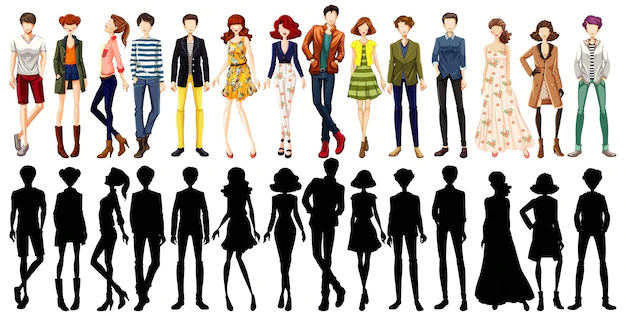Crafting a Versatile and Functional Wardrobe: A Strategic Approach
Developing a wardrobe that seamlessly integrates style and practicality requires a strategic, rather than impulsive, approach. This article presents a structured framework for building a functional and adaptable wardrobe, utilizing established principles of fashion psychology and consumer behavior. Key concepts such as the capsule wardrobe, color theory, and the principles of visual merchandising will be applied to create a cohesive and enduring personal style.
Foundational Principles: Establishing a Wardrobe Core
The foundation of a successful wardrobe lies in strategic investment in core pieces that transcend transient trends. These items provide the building blocks for countless outfit combinations, forming a versatile and adaptable foundation.
1. Establishing a Capsule Wardrobe: The concept of a capsule wardrobe, as defined by Susie Faux, involves creating a small collection of high-quality, interchangeable garments. This approach minimizes clutter while maximizing outfit possibilities. By focusing on pieces that complement each other harmoniously, effortless mixing-and-matching becomes achievable. This aligns with the principles of minimalism and conscious consumption.
2. The Strategic Use of Neutral Colors: Neutral colors—black, white, gray, and navy—serve as foundational elements within a versatile wardrobe. These colors act as a blank canvas, allowing for the seamless integration of bolder colors and patterns without compromising the overall aesthetic coherence. This application of color theory creates visual harmony and allows for greater outfit flexibility.
3. Strategic Incorporation of Color Accents: While neutrals form the base, strategic additions of vibrant colors inject personality. Accessories, such as scarves, handbags, and shoes, serve as ideal vehicles for introducing color accents that complement the neutral foundation, thereby enhancing dynamism and individual expression. This leverages the principles of visual merchandising, using strategic color placement to create focal points.
4. Prioritizing Comfort and Fit: Comfort is paramount. Garments should flatter the individual's body shape, fostering confidence and self-assuredness. Ill-fitting clothes detract from the overall appearance and undermine the positive psychological impact of well-chosen apparel. This emphasizes the importance of body positivity and the psychological benefits of well-fitting clothing.
5. Investing in Timeless Classics: A well-tailored blazer, a classic little black dress (LBD), or a crisp white shirt represent timeless wardrobe staples. These versatile pieces effortlessly transition between formal and informal occasions, offering exceptional long-term value. The investment reflects the principle of enduring style over fleeting trends.
Expanding Wardrobe Depth and Versatility: Advanced Techniques
Extending the wardrobe beyond foundational pieces requires a considered approach. Layering and accessorizing open up a wealth of styling possibilities, generating diverse outfits from a relatively compact collection.
6. Mastering the Art of Layering: Layering adds depth and visual interest. Lightweight cardigans, blazers, or vests transform simple outfits into sophisticated ensembles. Experimenting with various textures and weights yields unique looks suitable for diverse climates and occasions. This employs the principles of visual layering and texture play, enhancing outfit complexity.
7. Tailoring: Transforming Garments: Tailoring dramatically improves fit and appearance. Investing in alterations transforms average pieces into perfectly fitted garments, enhancing silhouette and creating a polished appearance. This application of bespoke tailoring significantly increases the perceived value and wearability of existing garments.
8. Lifestyle-Driven Wardrobe Choices: The wardrobe should reflect the individual's lifestyle. Professionals should prioritize pieces suitable for business settings, while those with active lifestyles should invest in functional and stylish activewear. This approach ensures the wardrobe aligns with daily needs and activities.
9. The Power of Accessories: Accessories are transformative. Statement necklaces, versatile belts, or a quality watch instantly elevate even simple outfits, adding personality and individuality. This highlights the strategic importance of accessories in personal style expression.
10. The Role of Wardrobe Basics: Plain t-shirts, well-fitting jeans, and leggings form the backbone of the wardrobe, providing essential building blocks for numerous combinations. These items represent versatile and cost-effective additions to any wardrobe.
Long-Term Wardrobe Strategies: Quality, Versatility, and Sustainability
Creating a truly functional wardrobe demands consideration of quality, versatility, and longevity. These strategies ensure the wardrobe endures and remains relevant over time.
11. Prioritizing Quality over Quantity: Investing in a few high-quality pieces surpasses accumulating numerous inexpensive items. High-quality materials and construction guarantee durability, providing superior long-term value and reducing consumption. This aligns with sustainable fashion principles.
12. Curating a Versatile Shoe Collection: Shoes are crucial. Investing in versatile pairs suitable for various occasions—classic pumps, comfortable flats, and stylish sneakers—creates a functional footwear foundation. This ensures footwear complements different outfit choices.
13. Experimenting with Patterns and Textures: Incorporating patterns and textures adds visual interest. Mixing prints or contrasting textures (e.g., a floral blouse with a leather jacket) creates unique and dynamic outfits. This showcases the creative potential within wardrobe choices.
14. Investing in Timeless Outerwear: A classic trench coat or a leather jacket provides polish and weather protection. These pieces remain stylish year after year, acting as perfect finishing touches. This highlights the enduring appeal of classic outerwear designs.
15. Conducting Regular Wardrobe Audits: Regularly assess and edit the wardrobe. Remove unworn, ill-fitting, or outdated items. This keeps the wardrobe streamlined and functional, enhancing its overall efficiency.
Conclusions and Recommendations: Building a versatile and functional wardrobe is an ongoing process, not a single event. By applying the principles outlined above—incorporating elements of capsule wardrobe theory, color theory, and principles of visual merchandising—individuals can curate a wardrobe that reflects their personal style and adapts to evolving needs. Regular wardrobe audits ensure continued relevance and minimize waste. Further research could explore the psychological impact of wardrobe choices on self-esteem and consumer behavior relating to sustainable fashion practices. The principles discussed here are applicable across various socioeconomic backgrounds, provided adaptation is made to suit individual budgets and lifestyle.
Reader Pool: Considering the principles outlined in this article, what additional strategies could enhance the development of a truly versatile and sustainable wardrobe?




